
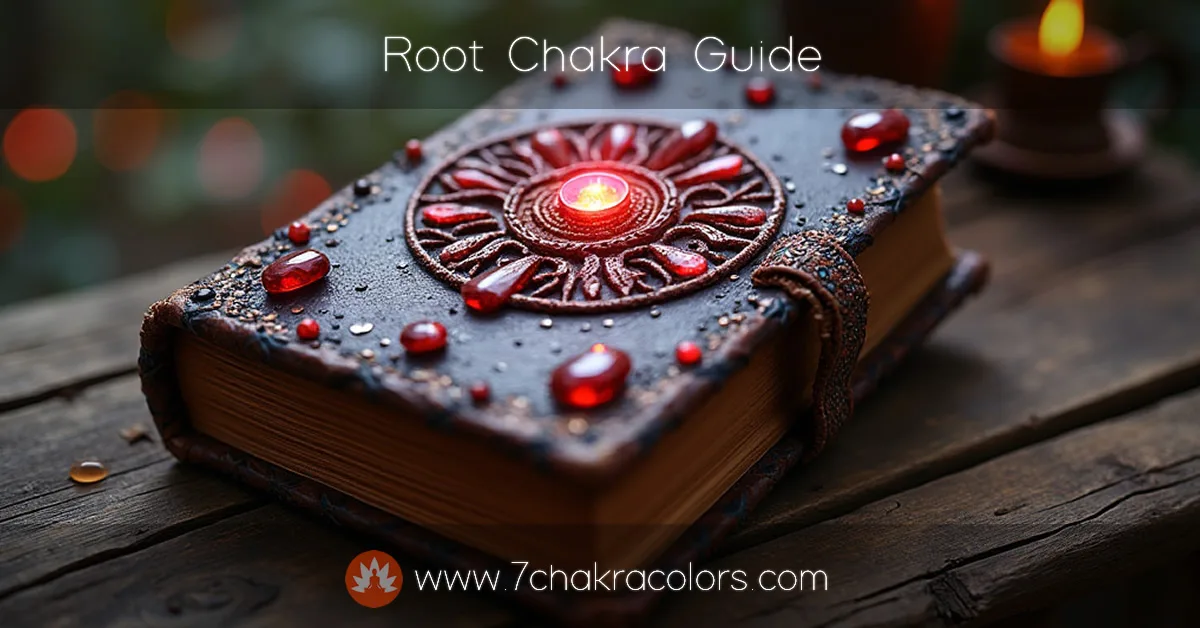
Discover the power of the Root Chakra with our comprehensive guide. Explore topics like Root Chakra tests, meditation techniques, yoga poses, affirmations, blockage symptoms, and more to enhance your energy foundation and find stability.
The Root Chakra is the first of the seven primary chakras in the body.
Your root chakra sits at the very bottom of your spine. Right at the coccyx - that's your tailbone. On the actual spine location, it is there (1), but when you tune into it, you'll feel the energy pooling at the base of your spine, sometimes radiating slightly down into your perineum or up into your lower sacrum.
This is the first chakra. Your foundation.
Everything else in your chakra system builds from here. If this one's unstable, the rest struggle. It's that simple.
Muladhara handles your sense of security, your grounding, your stability.
It connects you to earth energy - literally pulls it up from the ground beneath you. Except here's what's different about this chakra compared to the ones above it: the energy moves downward.
Your root chakra's job is to anchor. To drop energy down or pull it up, rooting you into the earth.
When it's working right, you feel safe. Secure. Like you can trust the ground beneath you - both literally and in your life. Your ability to relax, to feel supported physically and emotionally, all of that starts here.
Most people walk around with this chakra either blocked or scattered.
That restless feeling, like you can't settle. That's usually your root calling for attention.
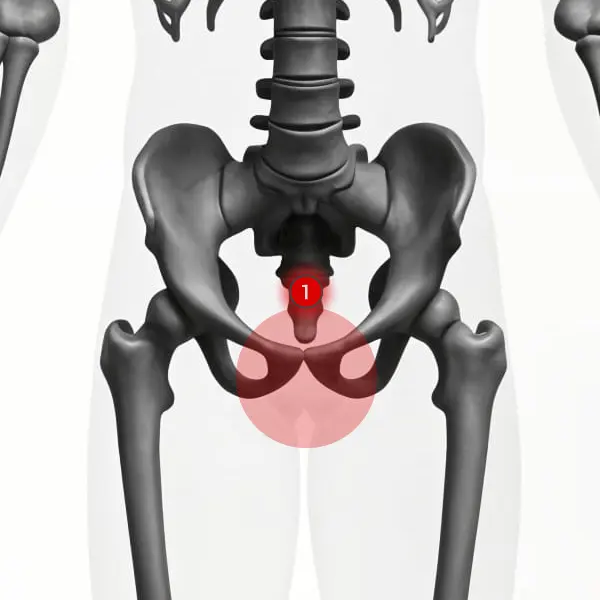
Diagram is showing where root chakra is located on your spine (red dot 1) and where the energy of the root chakra can be felt when you concentrate on it (transparent red circle)
The word "Muladhara", Sanskrit name for the first chakra, translates to "root support" or "base foundation."
It is composed of two Sanskrit words:
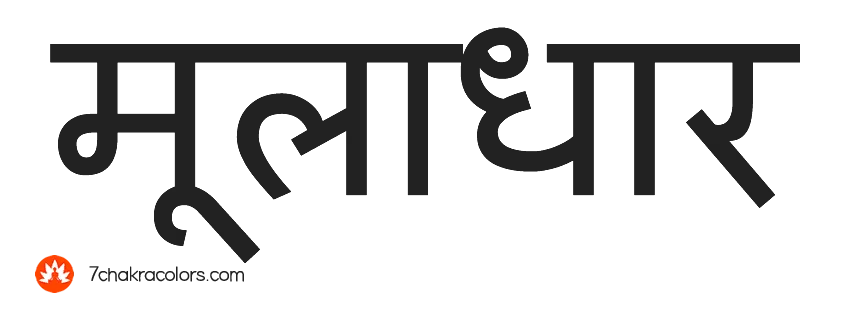
This chakra is also the seat of Kundalini energy and the entry point for energy into the body.
Acting as an anchor, the root chakra provides stability for daily life, especially during spiritual exploration. However, an imbalanced root chakra can obstruct energy flow to all other channels of vitality.
The location of the root chakra in the physical body is at the base of the spine, near the coccyx, in the pelvic area between the perineum and the anus.
In the energy body, the location of the root chakra is at the bottom of the energy system of the Nadi channels through which the vital energy (chi, prana) flows throughout the human energy body.
The root chakra is connected and rooted into the earth through the energy channels leading through our legs and feet below. It supplies the earthly energy to the sacral chakra which is located above it.
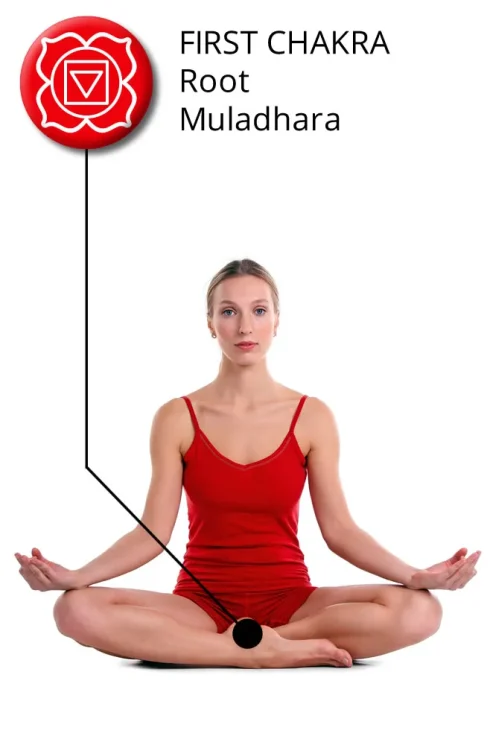


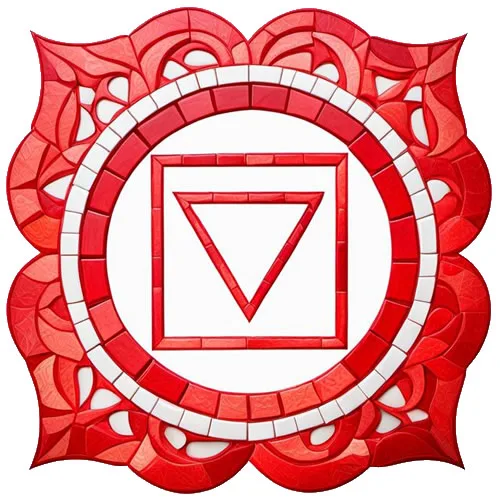
In Hinduism, the Muladhara chakra is depicted with four petals and a square, which symbolizes earth.
The root chakra symbol color is a deep vermilion red, which radiates through the energy vortex and represents life energy, power, and passion.
The root chakra symbol is traditionally represented by a square with four petals surrounding it. Here's a breakdown of its key elements:
Square: The central square represents stability, grounding, and the foundational aspects of life. It symbolizes the Earth element, providing a firm base and balance.
Four Petals: Surrounding the square are four petals, representing the four energies associated with the root chakra—mind, intellect, consciousness, and ego. These petals also symbolize the four directions (north, south, east, and west), grounding the individual in the physical world.
Downward-Pointing Triangle: Inside the square is a downward-pointing triangle, symbolizing energy and grounding force flowing downward, connecting with the Earth. This triangle is associated with the grounding energy of the root chakra.
Color: The root chakra is associated with the color red, symbolizing strength, vitality, and survival. The bright red used in the symbol reflects the energy, passion, and primal life force linked to the root chakra.
The elephant is a powerful animal symbol of the root chakra, representing stability and strength. As the largest land animal, the elephant embodies qualities of prosperity, security, soundness, abundance, and inner strength, which are the foundational elements of this energy center. Known for its strong connection to the earth, the elephant encourages a sense of grounding and physical endurance, essential for balancing the root chakra.
The elephant’s deep-rooted memory is symbolic of wisdom, reminding us to stay grounded while drawing on past experiences to guide our present journey. This symbol reinforces the importance of building a solid foundation in our lives, fostering feelings of safety and security.
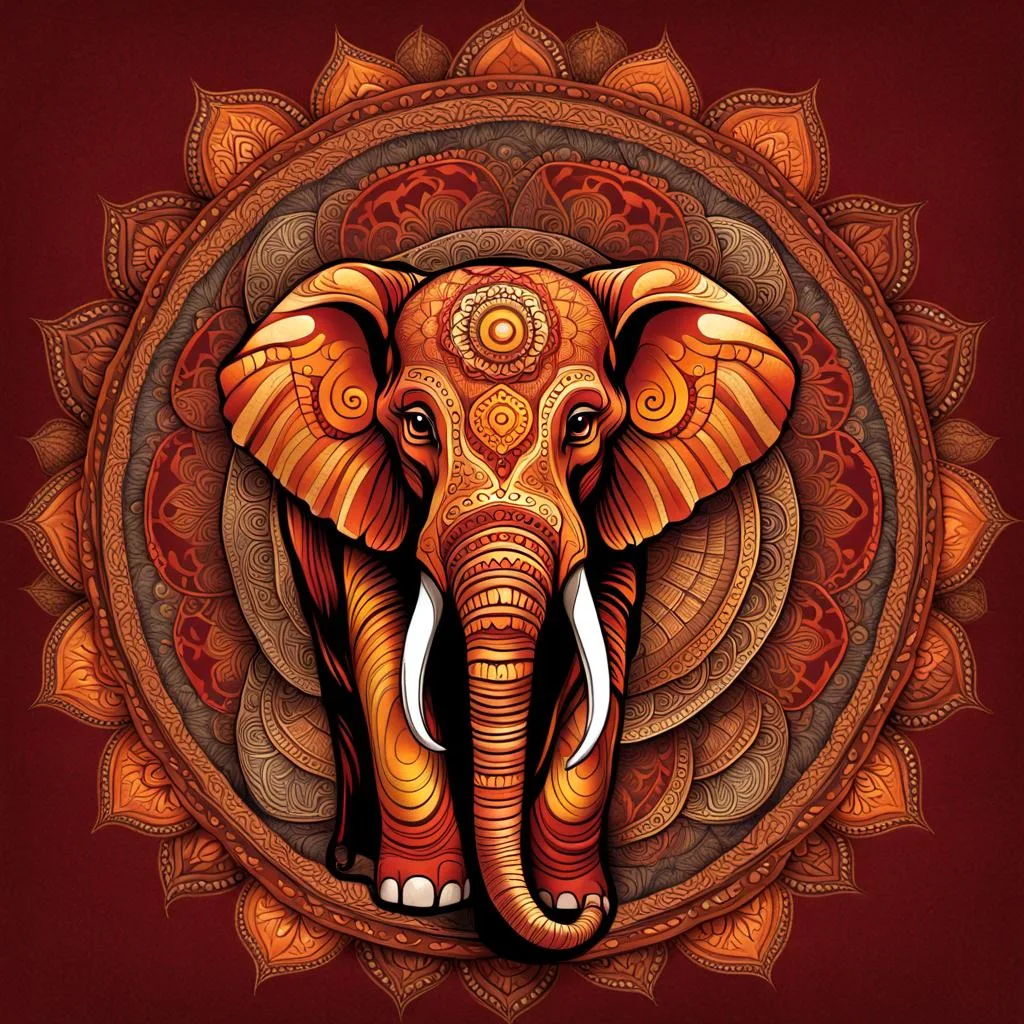
In addition to the elephant, two other animals serve as symbols of the root chakra: the bull and the ox. Both of these animals share similar qualities of strength, resilience, and determination. The bull, with its firm stance and powerful presence, represents stability and perseverance, while the ox symbolizes hard work and tenacity, both essential for grounding energy in the root chakra.
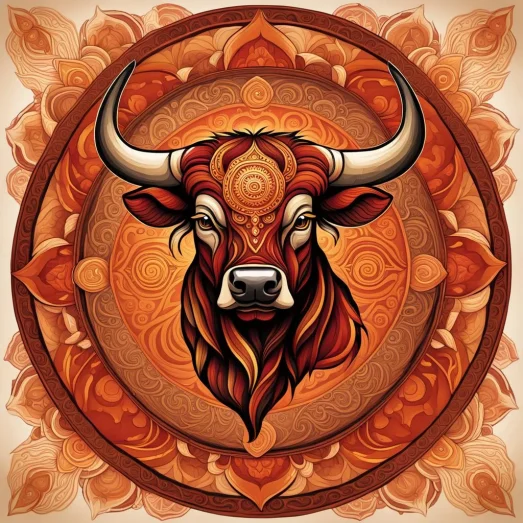
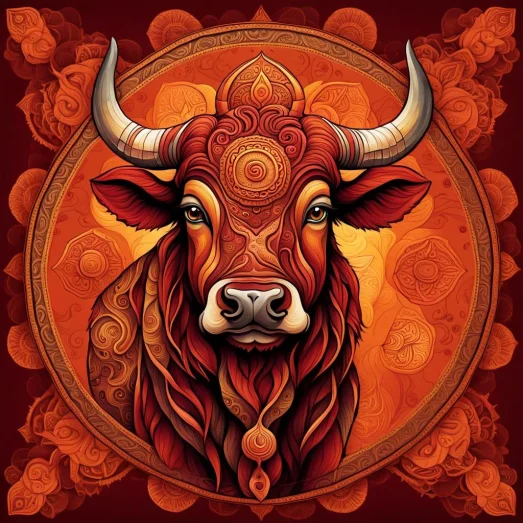
Together, the elephant, bull, and ox create a powerful trio of symbols for the root chakra, emphasizing the need for a secure foundation and a balanced connection to the earth. These animal symbols promote prosperity, abundance, and a sense of safety, all key elements in activating and harmonizing the root chakra.
If your root chakra is blocked, it can disrupt your sense of security and connection to the people and world around you.
This vital energy center influences your emotions (feelings of stability, safety and security), and also your physical health.
If you feel persistent anxiety, stress, a sense of disconnection, or even physical discomfort and pain in the lower body parts or internal organs, there is a big chance your root chakra is out of balance.
To promote its healing, the best thing to do is grounding. You do this by taking on activities that connect you to the earth, nature, and your physical body.
This helps you establish a firm base to move forward in your life with confidence, regardless of your life path.

The root chakra test is a powerful tool for assessing your foundational energy and understanding its impact on your overall well-being.
By evaluating your feelings of security, stability, and connection to the earth, this test helps identify any imbalances within the root chakra.
Participants can gain insights into how their physical health, emotions, and relationships are influenced by this vital energy center.
The test typically includes a series of introspective questions, encouraging individuals to reflect on their experiences related to survival, trust, and grounding.
A comprehensive understanding of your root chakra can empower you to cultivate a more balanced and fulfilling life, fostering a deeper connection to your inner self and the world around you.

Opening the root chakra brings a wave of revitalizing energy and a profound sense of grounding.
When this energy center is balanced, you may experience increased feelings of security and stability, leading to a stronger connection with your physical body and the earth.
Symptoms of an open root chakra include heightened self-confidence, reduced anxiety, and an enhanced ability to handle stress. You might also notice improved physical health, particularly in areas related to the lower body, such as the legs and feet.
Additionally, feelings of belonging and community can blossom, fostering healthier relationships and a deeper appreciation for life.
Embracing activities like yoga, meditation, or spending time in nature can further support this energetic shift, allowing you to thrive in your personal and professional life.

Root chakra stones and crystals play a crucial role in enhancing the energy of the first chakra, fostering stability and security.
These powerful gemstones, such as red jasper, hematite, and garnet, resonate with the root chakra's energy, helping to dispel negative emotions and promote a sense of grounding.
By incorporating these stones into your meditation or carrying them throughout the day, you can strengthen your connection to the earth and boost your confidence.
Each crystal has unique properties; for instance, red jasper encourages vitality and emotional stability, while black tourmaline offers protection against negativity.
Embracing these root chakra stones can facilitate healing and support your journey toward a balanced and empowered life.
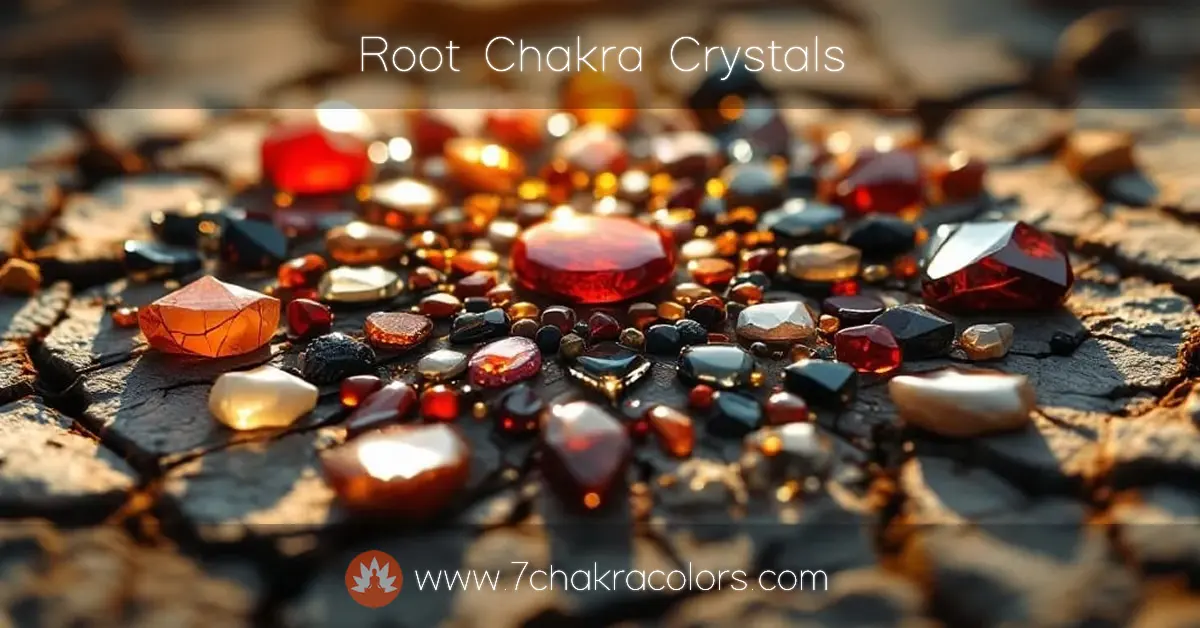


Root chakra meditation is a transformative practice designed to enhance feelings of safety, stability, and connection to the earth.
By focusing on the base of the spine, where the root chakra resides, practitioners can ground themselves and release any stagnant energy.
A simple yet effective meditation technique involves visualizing a vibrant red light at the base of the spine, expanding with each breath.
As you inhale, imagine this energy growing stronger, anchoring you to the earth, and with each exhale, release any fears or insecurities.
This practice not only promotes emotional well-being but also fosters a sense of belonging and trust in the world around you.
Incorporating root chakra meditation into your routine can create a solid foundation for personal growth and spiritual exploration.
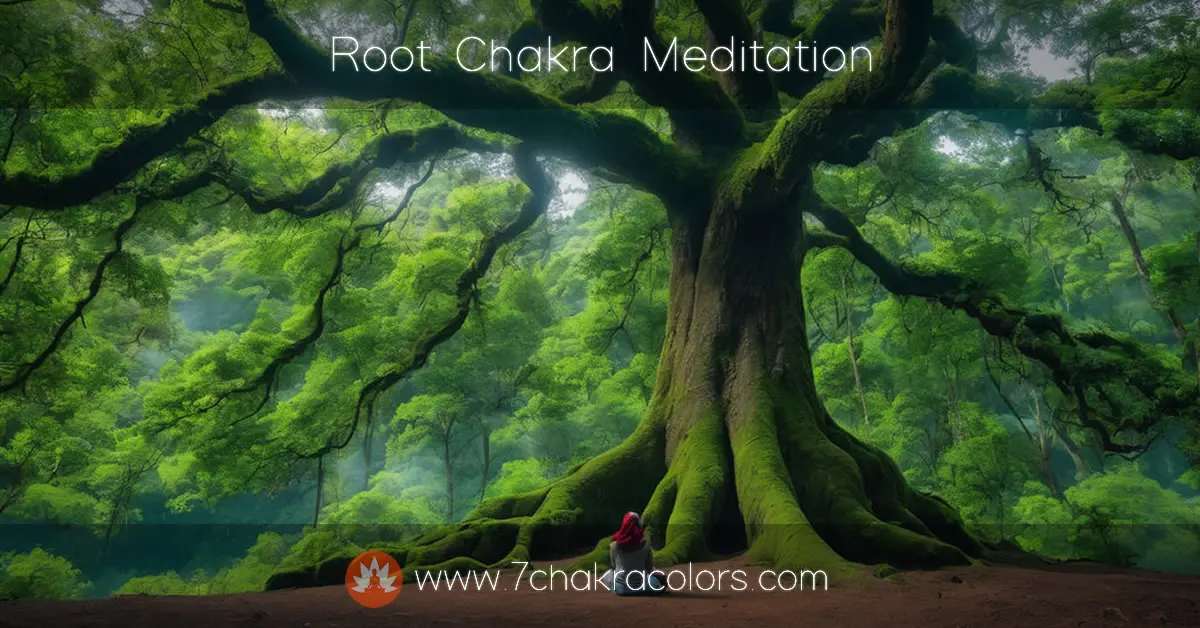
Root chakra affirmations serve as powerful tools to cultivate a sense of security and grounding in your life.
These affirmations are positive statements that reinforce your connection to the earth and enhance feelings of safety and stability.
Phrases like "I am safe and secure," "I trust the process of life," and "I am deeply rooted in the present moment" can transform your mindset and promote emotional well-being.
By repeating these affirmations daily, you can effectively clear blockages in the root chakra, fostering a stronger foundation for personal growth.
Integrating root chakra affirmations into your meditation or mindfulness practices can create a harmonious energy flow, empowering you to navigate life's challenges with confidence and resilience.

| Main Names | Root Chakra, First Chakra, Base Chakra, Muladhara, Foundational Center |
| Meaning of "Muladhara" | From Sanskrit, meaning root, support, or pillar |
| Location | Base of the spine (perineum) |
| Corresponding Gland | Adrenal glands, which produce hormones like adrenaline, aldosterone, and cortisol |
| Color | Red |
| Sound/Mantra | LAM (chanting or focusing on this sound can help balance the Root Chakra) |
| Number of Petals | Four petals, each with one of these Sanskrit syllables: वं (vaṃ), शं (śaṃ), षं (ṣaṃ), सं (saṃ) |
| Primary Themes | Survival, stability, grounding, ancient trust, material safety, and earthiness |
| Positive Aspects | Life energy, self-preservation, persistence, endurance, connection with earth and nature, astuteness |
| Negative Aspects | Instinct, existential dread, narcissism, laziness |
| Associated Body Parts | Legs, feet, bones, large intestine, lower back, pelvis, and rectum |
| Common Physical Ailments | Colon issues, frequent constipation, sciatica, kidney and bladder problems, bone diseases, lower back pain |
| Mental and Emotional Issues | Fear, powerlessness, lack of trust, anxiety, depression, attachment to perceived sources of security |
| Element | Earth |
| Primary Symbol | Square |
| Animal Symbols | Elephant, bull, ox |
| Associated Sense | Smell |
| Deities | Brahma, Dakini |
| Frequency | 256 Hz |
| Affirmations | "I am safe and secure." "I am grounded and stable." "I trust in the process of life." |
| Crystals | Red Jasper, Bloodstone, Hematite, Garnet, Smoky Quartz |
| Essential Oils | Patchouli, Cedarwood, Vetiver, Sandalwood, Frankincense |
| Yoga Poses | Mountain Pose (Tadasana), Warrior I (Virabhadrasana I), Warrior II (Virabhadrasana II), Tree Pose (Vrksasana), Bridge Pose (Setu Bandhasana) |
| Mudras | Earth Mudra (Prithvi Mudra), Gyan Mudra (for grounding), Bhairava Mudra (for inner strength) |
| Dietary Suggestions | Root vegetables (potatoes, carrots, beets), protein-rich foods, red-colored foods (apples, strawberries) |
| Positive Spiritual Traits | Life energy, connection to earth, perseverance, grounding, resilience, and safety |
| Nature Connection | Walking barefoot on natural surfaces, spending time in nature |
| Season | Winter |
| Associated Planets | Mercury |
| Personal and Professional Traits | Groundedness, stability, sense of security in personal and professional life |
| Self-Care Practices | Engaging in activities that reinforce security and grounding, mindfulness practices |
| Astrology | Associated with Saturn for discipline and structure |
| Healing Practices | Grounding exercises, deep breathing, mindfulness |
| Numerology | 1 (symbolizing new beginnings and grounding) |
| Relationship Dynamics | Healthy, stable family relationships, secure friendships |
The root chakra, also known as Muladhara, is the first of the seven main chakras located at the base of the spine. It is responsible for your sense of security, grounding, and physical survival, affecting how stable and connected you feel in the world.
The root chakra represents safety, security, and physical survival. It governs basic needs like shelter, food, and financial stability, as well as feelings of being grounded and connected to the world.
The root chakra, or Muladhara, means "root support." It is the foundation of your energy system, providing stability and grounding.
The root chakra is associated with the color red because it symbolizes strength, passion, and primal energy, connected to survival instincts and grounding in the physical world.
The root chakra is represented by the color red, which symbolizes strength, passion, and survival instincts.
The root chakra is associated with the frequency of 396 Hz, which promotes a sense of grounding and safety.
The root chakra governs our sense of stability and security, helping us feel grounded, connected to nature, and able to navigate life’s challenges smoothly.
The root chakra is balanced when you feel secure, grounded, and connected. You have emotional confidence, physical well-being, and a stable sense of safety.
A weak root chakra may cause distraction, fatigue, and feelings of instability or insecurity.
When the root chakra opens, you experience a deep sense of security, stability, and grounding, with improved physical health and emotional resilience.
When the root chakra is open, you feel grounded, calm, secure, and more connected to your body with a positive outlook on life.
An overactive root chakra can lead to feelings of anxiety, possessiveness, materialism, and survival-mode thinking, with physical issues like weight gain or digestive problems.
Fear and trauma can block the root chakra, leading to sluggishness, eating disorders, anxiety, fear, panic attacks, depression, and emotional disconnection.
A blocked root chakra may manifest as hoarding, greed, lack of ambition, insecurity, isolation, anxiety, depression, and self-pity.
A blocked root chakra can make you feel distracted, exhausted, or lethargic. Physically, it may cause arthritis, knee pain, or digestive issues, while emotionally, it may result in insecurity and fear.
A blocked root chakra may manifest as physical issues in the legs, feet, rectum, or immune system, and emotional symptoms like insecurity around money, food, and shelter.
To unblock the root chakra, you can reconnect with nature, use positive affirmations, practice yoga, meditate, and surround yourself with the color red.
Healing the root chakra can be achieved by reconnecting with nature, walking outdoors, meditating, or relaxing under a tree.
Practices like grounding meditation, specific yoga poses, and positive affirmations are effective ways to unblock your root chakra.
Grounding the root chakra can be done by walking barefoot on the earth, practicing grounding yoga poses, meditating with grounding crystals, and deep breathing.
Frequencies between 228Hz and 456Hz are believed to aid in healing the root chakra.
Signs of healing include feelings of warmth or tingling, increased vitality, better sleep, and a sense of grounding.
Red foods like tomatoes, strawberries, raspberries, cherries, red apples, peppers, pomegranates, and beets are beneficial for the root chakra.
A smoothie with ingredients like beets, raspberries, strawberries, and blood oranges can help nourish the root chakra.
Red Jasper, Garnet, Black Tourmaline, and Smoky Quartz are grounding stones that help balance the root chakra.
Essential oils like Agarwood, Amyris, Angelica Root, and Atlas Cedarwood are excellent for balancing the root chakra.
The root chakra is tied to feelings of being grounded, providing a sense of safety and security.
Trauma related to physical survival, such as diseases, near-death experiences, violence, or financial struggles, can block the root chakra.
The root chakra holds trauma, particularly those related to physical survival and generational traumas.
Yes, the root chakra is related to wealth as it governs feelings of security, survival, and material abundance.
The ring finger is associated with the root chakra.
The Muladhara Mudra is commonly used to activate the root chakra.
The root chakra of the Earth is believed to be located at Mount Shasta in California, USA.
A vibrating sensation in your root chakra could indicate energy movement, often signaling that the chakra is becoming more active or aligning with higher frequencies.
Tingling in the root chakra may indicate activation or healing, often as blockages are released.
Pain in the root chakra area could signal an imbalance or blockage, stemming from unresolved emotional issues or physical conditions in the lower back, legs, or pelvic area.